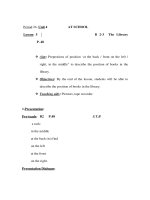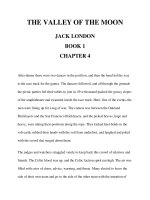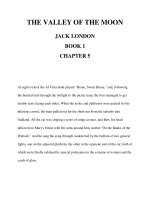4 6 5 the moon
Bạn đang xem bản rút gọn của tài liệu. Xem và tải ngay bản đầy đủ của tài liệu tại đây (4.8 MB, 12 trang )
Suggested levels for Guided Reading, DRA,™
Lexile,® and Reading Recovery™ are provided
in the Pearson Scott Foresman Leveling Guide.
Genre
Expository
nonfiction
Comprehension
Skills and Strategy
• Graphic Sources
• Main Idea and
Details
• Monitor and Fix Up
Earth Science
Text Features
•
•
•
•
Diagrams
Heads
Captions
Labels
Scott Foresman Reading Street 4.6.5
ISBN 0-328-13499-6
ì<(sk$m)=bdej b< +^-Ä-U-Ä-U
by Tess Mason
Vocabulary
astronauts
capsule
hatch
horizon
lunar
module
quarantine
Word count: 1,601
Reader Response
1. How did the diagram on page 7 help you
understand the phases of the Moon?
2. What questions did you have while you were
reading? What strategies did you use to answer
your questions?
3. Homonyms are words that are spelled the same
but have different meanings. Write two meanings
for the word hatch. Write a sentence for each of
those meanings.
4. Reread the section of the book called “Journey to
the Moon” on pages 10 through 15. Using a chart
similar to the one below, draw a time line to show
important events from this section of the book.
Date
by Tess Mason
Note: The total word count includes words in the running text and headings only.
Numerals and words in chapter titles, captions, labels, diagrams, charts, graphs,
sidebars, and extra features are not included.
Editorial Offices: Glenview, Illinois • Parsippany, New Jersey • New York, New York
Sales Offices: Needham, Massachusetts • Duluth, Georgia • Glenview, Illinois
Coppell, Texas • Ontario, California • Mesa, Arizona
Earth’s Neighbor
Humans have always been interested in the moon.
The moon is our closest neighbor. Look up from the
horizon into the night sky. The moon appears as the
largest object in the sky.
Some people have worshipped the moon. The
Romans may have worshipped Diana as the goddess
of the moon. The Greeks called their moon goddess
Artemis. Some people thought they could see a face
on the moon’s surface. This feature has been called
“the Man in the Moon.” People finally made rocket
ships to fly to the moon. Getting to know our closest
neighbor is an ongoing and exciting journey.
Every effort has been made to secure permission and provide appropriate credit for
photographic material. The publisher deeply regrets any omission and pledges to
correct errors called to its attention in subsequent editions.
Unless otherwise acknowledged, all photographs are the property of Scott Foresman,
a division of Pearson Education.
Photo locators denoted as follows: Top (T), Center (C), Bottom (B), Left (L), Right (R),
Background (Bkgd)
Artemis (left) was the Greek
goddess of the moon. A wolf
howls at the moon (below).
Opener: (T) Fred Espenak/Photo Researchers, Inc., (C) Brand X Pictures, (B) Kenneth
W. Fink/Photo Researchers, Inc.; 1 (TC) Kenneth W. Fink/Photo Researchers, Inc., (BC)
Brand X Pictures; 3 (BL) Scalá Art Resource, NY, (B) Kenneth W. Fink/Photo Researchers,
Inc.; 4 Brand X Pictures; 5 (BL) Digital Vision, (BC) Brand X Pictures; 6 Fred Espenak/
Photo Researchers, Inc.; 7 ©John Sanford/Photo Researchers, Inc.; 8 DK Images; 9 (B)
Brand X Pictures, (C) DK Images; 10 (B) Brand X Pictures, Sovfoto/Eastfoto; 11 (C) Getty
Images, (B) Image Ideas; 12 (CL) Brand X Pictures, (BR) ©Royalty-Free/Corbis; 13 Brand
X Pictures; 14 NASA; 15 (BR) Brand X Pictures, (T) NASA; 16 NASA; 17 NASA; 18 (CL)
DK Images, (B) NASA; 19 Brand X Pictures; 20 Brand X Pictures
ISBN: 0-328-13499-6
Copyright © Pearson Education, Inc.
All Rights Reserved. Printed in China. This publication is protected by Copyright,
and permission should be obtained from the publisher prior to any prohibited
reproduction, storage in a retrieval system, or transmission in any form by any
means, electronic, mechanical, photocopying, recording, or likewise. For information
regarding permission(s), write to: Permissions Department, Scott Foresman, 1900 East
Lake Avenue, Glenview, Illinois 60025.
4 5 6 7 8 9 10 V0H3 14 13 12 11 10 09 08 07 06
3
Moon versus Earth
The moon is Earth’s only natural satellite. A satellite
is an object that orbits, or moves around, another
object. The moon orbits Earth, as Earth orbits the sun.
We say that the moon is a natural satellite because it
is not man-made.
Earth
The moon differs from Earth in other ways as well.
Much of Earth is covered in water. But the moon has
no water. The moon also has no atmosphere. On the
moon, because there is no air, there is no weather.
Astronomers, or people who study outer space,
first thought the dark areas that they saw on the
moon might be seas. These areas are actually lava
flows that cooled and hardened. Today astronomers
still call them seas, such as the Sea of Tranquility. The
moon’s surface, or the lunar surface, is covered with
craters, or holes. Some are more than one hundred
miles across.
Moon
The moon orbits around Earth.
The moon appears to be quite large due to its
closeness to Earth. It is actually much smaller than
Earth. Think of a basketball and a tennis ball. The
basketball represents Earth. The tennis ball represents
the moon.
There are craters on
the moon.
4
5
Phases of the Moon
We only see the moon when the sun shines on
it. And we only see one side of the moon. Different
parts of the moon receive sunlight as it orbits Earth.
This causes the phases of the moon.
Sometimes, the moon is almost in a line between
Earth and the sun. This stops sunlight from reaching
the side of the moon facing us. It makes the moon
seem to vanish. This phase is called the New Moon.
As days go by, more of the sunlit moon can be
seen. The moon is said to be waxing. The waxing
Crescent Moon comes after the New Moon. Then, a
few days later, the First Quarter Moon appears. The
next phase is the waxing Gibbous Moon. Now more
than half of the moon appears, but not quite a whole
circle.
Finally, the entire side of the moon facing us is lit.
The moon appears as a full circle, or as the Full Moon.
Then the moon stops waxing and begins waning.
Waning is when the moon appears to get smaller. The
moon goes back through its phases during waning.
Full Moon
Gibbous Moon (waning)
Gibbous Moon (waxing)
Last Quarter (waning)
First Quarter (waxing)
The moon’s phases as
they appear from Earth
Crescent Moon (waning)
Crescent Moon (waxing)
New Moon
6
7
Eclipses
The moon plays an important part in eclipses. An
eclipse occurs when an object in space moves in front
of another object in space. As you know, the moon
orbits Earth, as Earth orbits the sun. When Earth
passes between the moon and the sun, it makes a
shadow on the moon. This is called a lunar eclipse.
The moon can still be seen in a lunar eclipse. It turns a
reddish, copper color because of Earth’s shadow.
Lunar eclipse
8
When the moon passes between Earth and the
sun, the moon blocks out the sunlight for a few
minutes. This is called a solar eclipse. If the moon
blocks out just a part of the sun, it is called a partial
eclipse. If it covers the entire sun, it is called a total
eclipse. During a total solar eclipse, you can see the
sun’s corona, or outer layer. You normally can’t see
the corona because the sun is too bright to look at
without the moon blocking its rays.
Solar eclipse
9
Journey to the Moon
For many years scientists have used telescopes to
learn about the moon. But they could not find out
everything they needed to know this way. People
wanted to go to the moon.
By the late 1940s, the United States and the Soviet
Union were involved in the Cold War. The Cold War
did not lead to actual fighting. It was a fight over
political systems and ideas.
On October 4, 1957, the Soviet Union launched
Sputnik 1, the world’s first man-made satellite. The
United States felt the need to compete. The launch of
Sputnik 1 began the space race.
In order to travel from Earth to the moon, scientists
needed something to propel, or push, a ship there
and back again. Making a powerful rocket was the
best solution.
Rockets have a long history. Thousands of years
ago, the Chinese invented gunpowder, which came
before rockets. The first actual rocket was a Chinese
fire arrow, invented before 1232. People made
rockets for hundreds of years before they understood
the science behind them.
Fire rocket
A scientist works
on Sputnik 1.
Chinese firecracker
10
11
A rocket is a chamber that holds a gas under
pressure. A small opening at one end of the chamber
allows the gas to escape. This propels, or moves, the
rocket in the opposite direction of the escaping gas.
Think of a balloon. The gas in it is air. The chamber
is the wall of the balloon. The rubber walls of the
balloon put pressure on the air. If you poke a hole in
the balloon, the pressure causes the air to escape. The
balloon flies off. Rockets are an
advanced version of this idea.
In the 1900s, scientists
used liquid fuel to propel
the rockets. The Saturn
V rocket was the largest
rocket ever built by the
United States.
The Saturn V rocket
was made to send a
crew to the moon.
12
The John F. Kennedy Space Center
at Cape Canaveral, Florida
On October 1, 1958, the National Aeronautics
and Space Administration, or NASA, was formed. On
May 25, 1961, President John F. Kennedy announced
that the United States would commit itself to landing
an astronaut on the moon before the end of the
decade.
The Soviets still led the space race, though. They
put the first person into space. On April 12, 1961,
Soviet Yury Gagarin completed one orbit of Earth in
the Vostok 1. It was a small vehicle, or capsule. On
February 20, 1962, John H. Glenn, Jr. became the first
U.S. astronaut to orbit Earth.
13
In the 1960s, the NASA space flight project known as
Gemini used two astronauts to practice flight in space.
The astronauts tested such operations as docking with
spacecraft and moving both inside and outside of the
spacecraft. On June 3, 1965, Edward H. White II became
the first U.S. astronaut to conduct a space walk. He was
connected to the spacecraft by a tether, or cord.
NASA kept working toward its goal of landing
a man on the moon before the end of the 1960s.
NASA’s Apollo program was designed to land men on
the moon and then bring them safely back to Earth.
Apollo missions 1 to 10 provided the final links for
the trip to the moon. They tested the Saturn V rocket
systems that would propel the spaceship to the moon.
Sadly, not all the test missions went smoothly. A fire on
board Apollo 1 caused three astronauts to lose their
lives. NASA quickly corrected the problems that led to
the fire, so that later astronauts were safe. On Apollo
8, the first humans orbited the moon. Now, the next
big step was to land.
Edward H. White II was connected
to the spacecraft by a tether in
the first American space walk.
Astronauts get ready
for space travel.
14
15
Apollo 11 and the Moon Today
NASA was ready to land on the moon with the
Apollo 11 mission. The crew consisted of commander
Neil A. Armstrong, lunar module pilot Edwin E.
“Buzz” Aldrin, Jr., and command module pilot
Michael Collins. The command module Columbia was
the crew’s main living quarters. Its service module
contained supplies. The lunar module Eagle was the
landing craft. The Eagle would be used to go down
to the moon’s surface and then back to the Columbia.
On July 16, 1969, the spacecraft lifted off from Earth.
It took four days to reach the moon. When the
astronauts got to the moon, Collins piloted the
Columbia. Armstrong and Aldrin used the Eagle to
go down to the surface of the moon. On July 20,
1969, the astronauts touched down on the surface of
the moon. “The Eagle has landed,” Armstrong said,
just after he landed in the Sea of Tranquility. Then he
stepped out onto the moon’s surface, becoming the
first human to set foot on the moon.
Armstrong and Aldrin collected soil and rock
samples, took photographs, and did experiments.
Then they used the Eagle to go up from the moon’s
surface and dock with the orbiting Columbia to return
to Earth. After Armstrong and Aldrin joined Collins,
the Eagle drifted off into space. It orbits the moon to
this day.
Astronaut “Buzz” Aldrin takes
his first walk on the Moon next
to the lunar module Eagle.
The Apollo 11
mission carried
astronauts Neil
Armstrong,
Michael Collins,
and Edwin
“Buzz” Aldrin
(left to right).
16
17
The command module of the Columbia separated
from its service module before entering Earth’s
atmosphere. On July 24, 1969, the command module
splashed into the Pacific Ocean. The astronauts
opened the hatch and exited their craft. They wore
special suits and went into quarantine, a place or
time in which people are held until it is determined
that they have no diseases. After that, the astronauts
were able to see their family and friends.
The service module
held supplies.
Six Apollo missions landed on the moon and
returned to Earth. No astronauts have visited the
moon since 1972.
Humans are still fascinated by the moon. NASA’s
space program has continued to grow since the
Apollo missions. In 2004, President Bush announced a
plan to return to the moon. Perhaps
one day people will live and
work on the moon. The
moon will inspire people
for centuries to come.
The command module
was the main living
quarters.
The command module
splashed down in the
Pacific Ocean.
18
A space shuttle flight
lifts off from Cape
Canaveral, Florida.
19
Glossary
Vocabulary
astronauts
astronaut n. a member
of the crew of a
capsule
spacecraft.
capsule
n. the enclosed
hatch
front section of a rocket
that carries astronauts,
horizon and other
instruments,
equipment into space.
lunar
hatch n. a small door
or opening, as in a
module
spaceship; the covering
for such an opening.
quarantine
Reader Response
lunar adj. of, like, or
about the moon.
1. How did the diagram on page 7 help you
understand the phases of the Moon?
module n. a
self-contained unit or
system within a larger
system, often designed
for a particular function.
2. What questions did you have while you were
reading? What strategies did you use to answer
your questions?
quarantine n.
detention, isolation, and
other measures taken
to prevent the spread of
an infectious disease.
horizon n. the line
where Earth and sky
appear to meet; skyline.
Word count: 1,601
Note: The total word count includes words in the running text and headings only.
Numerals and words in chapter titles, captions, labels, diagrams, charts, graphs,
sidebars, and extra features are not included.
20
3. Homonyms are words that are spelled the same
but have different meanings. Write two meanings
for the word hatch. Write a sentence for each of
those meanings.
4. Reread the section of the book called “Journey to
the Moon” on pages 10 through 15. Using a chart
similar to the one below, draw a time line to show
important events from this section of the book.
Date









